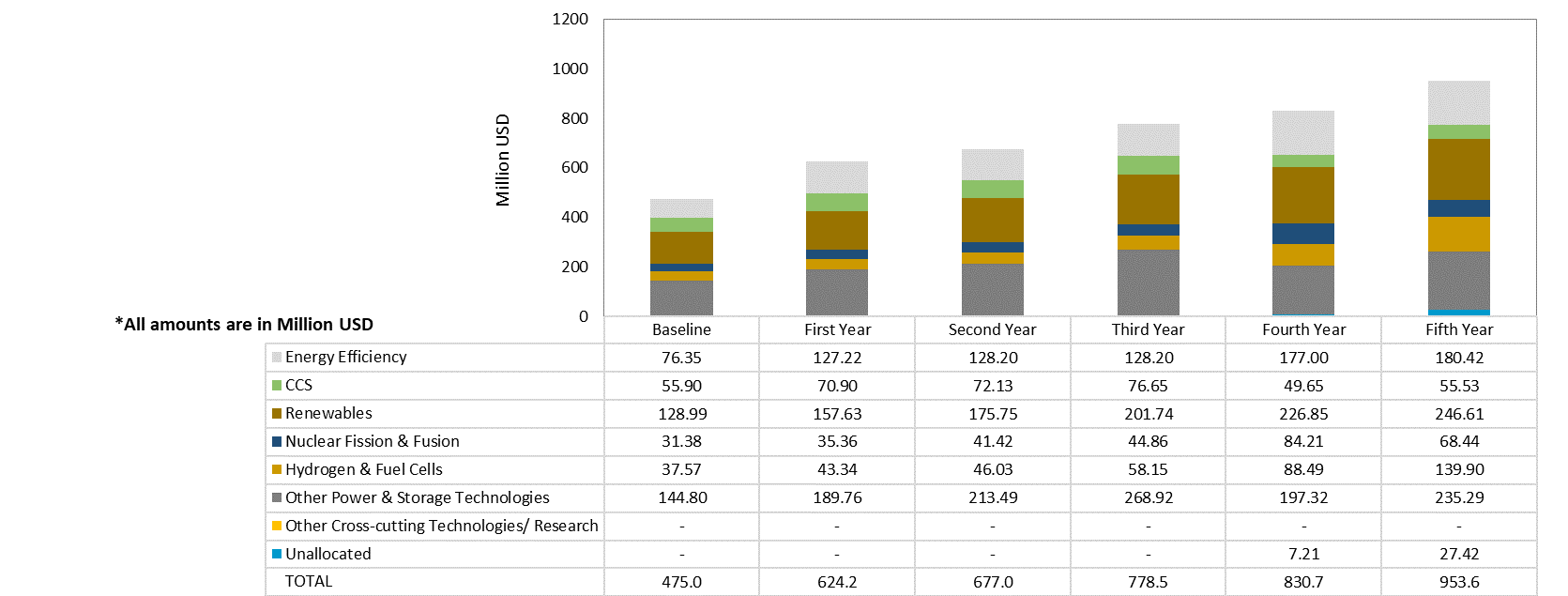Highlights in 2020
High impact innovation activity triggered by MI
Korea clean energy technology R&D investment in the public sector in 2021 is about 1,132.6 billion KRW, 106% up since 2016.
This includes the government budget of 860 billion won increased by 89.6% since 2016 and state-owned company budget is 270 billion won, increased by 152.6% since 2016.
Update on clean energy innovation policies and strategies
In December 2020, the Korean government announced ‘2050 Net-zero strategy’ in order to actively respond to the era of global economics transition toward Net-zero.
Three major policy directions have been established: Low carbonization of the economic structure, creation of an ecosystem for low carbon industries, and fair transition to a Net-zero society. The foundation of a Net-zero system will be strengthened.
- Acceleration of energy transition 2. Innovation of high-carbon industrial structure 3. Transition to future mobility 4. Low carbon in city and land 5. Fostering of new industry 6. Establishment of innovative ecosystem 7. Activation of circulation economy 8. Protection of vulnerable industrial levels 9. Realization of region-oriented net-zero 10. Increase public awareness of net-zero society
Major innovation initiatives and programmes in 2020/21
Ministry of trade, Industry, and Energy plans to increase the investment in energy R&D continuously.
In 2020, the government invested 956.6 billion KRW in strengthening renewable energy competitiveness, efficient energy consumption by technology convergence, improving system reliability, and building infrastructure.
Accomplished in commercializing floating solar PV, development and commercialization of the 4.3M wind-power system, and the world’s first 500kV scale HVDC cable technology.
In 2021, the MOTIE plans to invest 1,132.6 billion KRW in energy R&D in which has increased by 19% from last year.
Private sector engagement in 2020/21
On September 2020, MOTIE announced ‘Energy innovative company support strategy’ to foster new business models and revive the new energy industry system.
The government sets six promising fields and established three supporting strategies considering the systematic change in the energy industry, the company capacity and potential, and political direction.
Six promising fields: Solar PV Management, Distributed Generation Virtual Power Plant, Wind Power supporting Service, Electric Vehicle Battery Service, Material and Parts of Energy Industry, Management of Building Energy Efficiency.
Three supporting strategy: Supporting Tech R&D, Fostering Private Investment, Establishing the Framework of Support
On March 2020, KETEP and other organizations founded ‘Technology Innovation Fund’ on the scale of 280 billion KRW to actively support strengthening industrial competitiveness of small and medium enterprises.
KETEP (Korea Institute of Energy Technology Evaluation and Planning), KEIT (Korea Evaluation Institute of Industrial Technology), and KIAT (Korea Institute for Advancement of Technology) cooperate as the specialized agencies, and Industrial Bank of Korea, Shinhan Bank cooperate as the specialized banks.
The cooperators sets Korea Growth Investment Corporation, manages the Technology Innovation Fund and invests a proper amount of money in small and medium enterprises that need R&D funding.
Major activities in support of the Innovation Challenges in 2020/21
Korea has been participating in the Innovation Challenges, a group of experts in clean energy technology, since November 2016 to clarify the implementation of Mission Innovation.
Since the 4th MI Ministerial meeting in Canada, Korea declared its participation in the Hydrogen IC and participated in 6 of the total 8 ICs.
The MOTIE funds MI-oriented international joint research projects from Dec 2018 to Jan 2021. The budget is around $1 million per project every year.
This is delivered in cooperation with the USA, Canada, Germany, and India.
The government funds a total of eight projects in the field of innovation challenges and conducting various activities such as joint workshops, manpower dispatch, joint thesis discussion, research sample exchange, and demonstration plant visits.
Public sector RD&D investment
New Collaborations
- Collaborator: China
- Name of collaboration
- Bilateral Call for Key technology and demonstration of distributed CHP from biomass gasification combined with fluidized bed electrode SOFC system
- Brief Description
- Fabricating the combined Heat and Power system using dual fluidized-bed gasification with fluidzed bed electrode solid oxide fuel cell. Dual fluidized -bed gasifier realizes the low N2 contents in producer gas and supplies Heat energy to fuel cells operating temperature. Tar remover cleans the producer gas suitable to Fuel Cell and CO2 absorption technology reduces CO2 emissions.
- Sectors
- Public-Public
- Type of collaboration
- Demonstration
- Duration
- 2020 to 2023
- Funding amount
- KRW 1,320,000,000
- Name of collaboration
- Collaborator: India
- Name of collaboration
- Bilateral Call for Development of microgrid-linked solid oxide fuel cell system using diesel fuel
- Brief Description
- Developing reformer that can eliminate the harmful emissions of diesel & produce clean fuel. Generating clean, highly efficient and reliable electricity using solid oxide fuel cells. Testing proof of concept system (SOFC-3kW+SolarPV-2kW+Battery-10kWh) under simulated load conditions of rural micro-grid in laboratory conditions.
- Sectors
- Public-Public
- Type of collaboration
- Development
- Duration
- 2020 to 2022
- Funding amount
- KRW 500,000,000
- Name of collaboration
